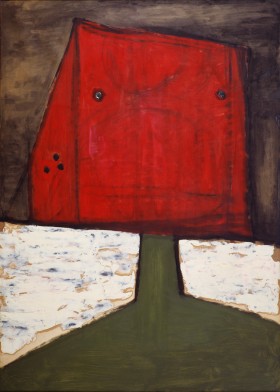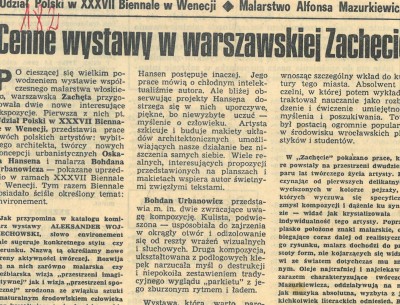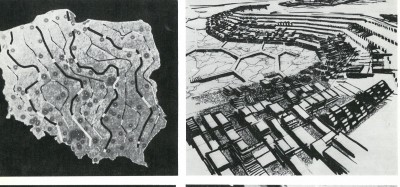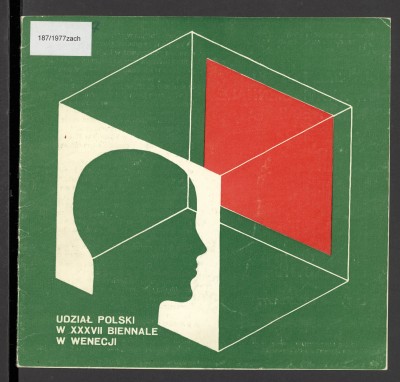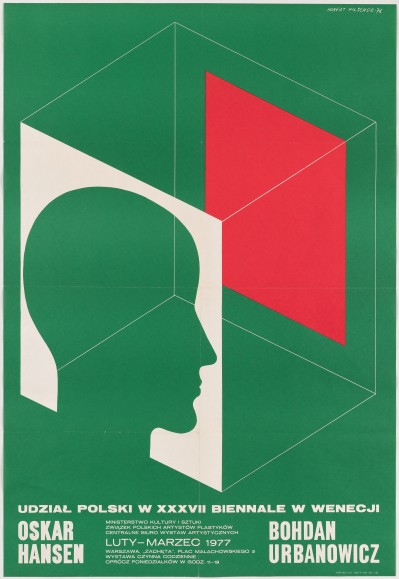Oskar Hansen, Bohdan Urbanowicz Polish Participation in the 37th International Art Exhibition – La Biennale di Venezia
21.02 – 20.03.1977 Oskar Hansen, Bohdan Urbanowicz Polish Participation in the 37th International Art Exhibition – La Biennale di Venezia
Zachęta Central Bureau of Art Exhibitions (CBWA)
organiser: Ministry of Culture and Art, Association of Polish Artists and Designers (ZPAP)
commissioner: Aleksander Wojciechowski
‘Representative exhibitions of Polish art, sent abroad, should be shown after returning home. The discussion will help the artists, and it will be useful to the exhibition organisers in their work — being a specific kind of social control in relation to the important period in the artist’s life that is today’s cultural exchange.’[1] This view, expressed by Aleksander Wojciechowski, the commissioner of the Polish exhibition at the 37th International Art Exhibition — La Biennale di Venezia in 1976, was to explain the motivation for its presentation at Zachęta.
The Italian event was organised around a generally defined, but fairly broad and ambiguous, theme (Ambiente, partecipazione, strutture culturali / Environment, Participation, Cultural Structures).[2] At Wojciechowski’s invitation, Poland was represented by Oskar Hansen and Bohdan Urbanowicz — at the time already artists of an older generation, professors at the Academy of Fine Arts in Warsaw. The former prepared boards with photographic documentation of the project and mock-ups devoted to the issue of Open Form and the Linear Continuous System (LCS). Urbanowicz presented the Eye and Distance project, whose leitmotif was an analysis of ‘visual contamination’ and a critique of big-city monoculture.
The Polish pavilion was not a success, rather overlooked by foreign observers, and considered a lost opportunity by the few domestic critics, which was confirmed by the short official opinion in the CBWA report.[3] The conflict between Hansen on one side and Urbanowicz and Wojciechowski on the other, over the introduction of decorations made of artificial red flowers, which ultimately did not happen, also testified to the poor atmosphere of the Polish team.[4]
Thus, the presentation of this exhibition at Zachęta did not seem obvious. Perhaps the words of Aleksander Wojciechowski, cited at the beginning, concealed the desire to clear the air after the failure in Venice (although some form of administrative coercion cannot be ruled out). Also noteworthy is a certain reserve (or perhaps only a courteous restraint) with which Bohdan Urbanowicz commented on his appearance at Zachęta in the commemorative brochure.[5]
There were no references to the circumstances of the exhibition in the commentary by Oskar Hansen, for whom it was another opportunity to present the idea of the Open Form: ‘Our model — the model of egalitarian society — requires settlement arrangements that would ensure, simultaneously with the development of society, the development of its environment. The human environment should encourage an increase in the level of life, not the standard of living [emphasis OH]. It is about creating a balance between humanity and its natural and technical environment, between civilisation and nature, and not just about an increase in the amount of goods-things produced per capita’.[6] In the quoted fragment, attention was drawn above all to the emphasis on the economic dimension of the LCS, even if it was done in a somewhat vague way.
If Wojciechowski was really hoping that Poland’s Participation . . . would provoke a public discussion, he would be disappointed. The exhibition triggered a very modest response in the press, which contained primarily statements based on self-commentaries of the artists. In the face of very poor visual documentation, the few-sentences-long descriptions of Urbanowicz’s work that the articles contained are also of some value.[7] It should be emphasised that there is a complete lack of texts on the overall appearance of Hansen’s exhibition.
Zbigniew Florczak was practically the only important voice, in a slightly picaresque convention signalling the lack of correlation between the concepts presented at the exhibition and the real living conditions and modest aspirations of the Polish People’s Republic at the threshold of a great crisis.[8] With a generally positive and kind attitude towards the artists, he noted: ‘Hansen is an architect who is entering the field of broadly understood visual arts. Urbanowicz is a painter, who wants to include visual arts in architectural compositions in a significant way — somewhat as an afterthought — or as an addition. These are tendencies that have been recognised and even warmly praised in culture for a long time. When it comes to their realisation, things are not so good.’ This was of great importance at a time when a ‘typical urban person placed all their ambitions and dreams, as far as a residence was concerned, in possession of an M3 or an M5 flat. They agree to live in an enormous beehive and praises God if the lift works and if there is a complex of basic shops nearby.’
Marek Czapelski
Institute of Art History of the University of Warsaw
This compilation was prepared as part of the National Programme for the Development of Humanities of the Polish Minister of Science and Higher Education — research project The History of Exhibitions at Zachęta — Central Bureau of Art Exhibitions in 1949–1970 (no. 0086/NPRH3/H11/82/2016) conducted by the Institute of Art History of the University of Warsaw in collaboration with Zachęta — National Gallery of Art.
Bibliography:
Catalogue:
- Oskar Hansen, Bohdan Urbanowicz. Udział Polski w XXXVII Międzynarodowym Biennale w Wenecji, commemorative brochures. Warsaw: Centralne Biuro Wystaw Artystycznych, 1977
- Wojciechowski, Aleksander. Polonia. XXXVII Biennale di Venezia ’76. Warsaw, 1976
Source texts:
- Florczak, Zbigniew. ‘Hansen i Urbanowicz’. Express Wieczorny, no. 66, 1977
- Hansen, Oskar. Towards Open Form, Warsaw, 2005, p. 227
- INC. ‘Człowiek i architektura’. Zwierciadło, no. 15, 1977
- Sosnowska, Joanna. Polacy na Biennale Sztuki w Wenecji 1895–1999. Warsaw, 1999, pp. 165–167, 238
- Szczawińska, Hanna. ‘Cenne wystawy w warszawskiej Zachęcie’. Słowo Powszechne, no. 55, 1977
Press mentions:
- Express Wieczorny, no. 43, 1977
- Trybuna Ludu, no. 44, 1977
[1] Aleksander Wojciechowski, introduction in the commemorative brochure Oskar Hansen. Bohdan Urbanowicz. Udział Polski w XXXVII Międzynarodowym Biennale w Wenecji, Warsaw: Centralne Biuro Wystaw Artystycznych, 1977.[2] The ambiente/environment pair of terms gave room for ambiguous interpretation, especially in the face of the growing presence of architectural issues at the Biennales in the 1970s. It should be noted that this decade was a difficult time for the event, which was experiencing a crisis — its 1974 edition did not take place at all.
[3] ‘Neither Hansen’s concept of systematising human needs nor Bogdan Urbanowicz’s reflections on ability and the specificity of human perception were adequately highlighted, which undoubtedly meant that their impact lost strength and attractiveness.’ Joanna Skoczylas, ‘Sztuka dla kogo?’, Polityka, no. 34, 1976, p. 10.
[4] The reception of the pavilion and the aforementioned conflict is discussed by Joanna Sosnowska, Polacy na Biennale Sztuki w Wenecji 1895–1999, Warsaw: IS PAN, 1999, pp. 165–167.
[5] ‘I did not apply to participate in the Biennale in Venice; existing there, I could not be an observer and a critic, because I was obliged by loyalty to competing partners. Today, I am faced with the fact of the verification of my Venice exhibition at “Zachęta”. Amen. So, like my painter friends, I stand before the Areopagus of opinion or silence and defend the sense of my work as much as I can.’ [Bohdan Urbanowicz], ‘Od autora’, in Oskar Hansen. Bohdan Urbanowicz. . .
[6] Oskar Hansen, ‘Forma Otwarta’, in Oskar Hansen. Bohdan Urbanowicz . . .
[7] ‘Bohdan Urbanowicz presents, among other things, two noteworthy compositions. The spherical, suspended composition made it possible to look into the round opening and isolate oneself from the rest of the visual and auditory impressions. The second composition, shaped out of floor slats, imposed the thought of destruction and disturbed with the juxtaposition of a traditional appearance of a “parquet” with its ruined rhythm and order.’ Hanna Szczawińska, ‘Cenne wystawy w warszawskiej Zachęcie’, Słowo Powszechne, no. 55, 1977, p. 5.
[8] Zbigniew Florczak, ‘Hansen i Urbanowicz’, Express Wieczorny, no. 66, 1977, p. 6.
Oskar Hansen, Bohdan Urbanowicz
Polish Participation in the 37th International Art Exhibition – La Biennale di Venezia
21.02 – 20.03.1977
Zachęta Central Bureau of Art Exhibitions (CBWA)
pl. Małachowskiego 3, 00-916 Warsaw
See on the map
